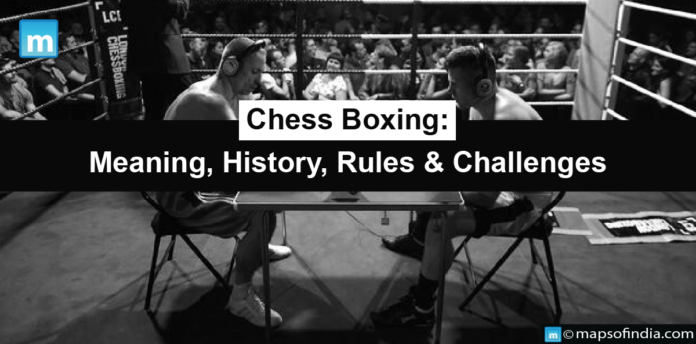Chess Boxing is a hybrid sport that combines the two conventional sports of boxing and chess. Blitz chess and boxing rounds alternate between competitors until one prevails via checkmate or knockout. In addition, a boxing judgment can resolve a draw in the chess round like in regular chess. Even though it may seem strange to combine physical prowess with academic prowess, Chess Boxing has developed into a sport that tests both the body and the mind.
History Of Chess Boxing:
Chess Boxing can be traced back to the creative mind of Enki Bilal, a French comic book artist who created a graphic novel titled “Froid Équateur” in 1992. Bilal established the concept of a chessboxing contest between two characters in this dystopian tale, illustrating the dualism of human existence. In 2003, Dutch artist Iepe Rubingh arranged the first true Chess Boxing match in Amsterdam, transferring the sport from the pages of a comic book to the real world. The sport has been popular since then, with professional and amateur leagues running worldwide.
Rules Of The Game:
-
Chess Rounds
The first round of chess in every Chess Boxing match lasts between three and four minutes. At a chessboard, the participants are seated across from one another and engage in a chess game using the traditional rules. The chess game is over when a player is checkmated, exhausts the time remaining on their chess clock, or exceeds the permitted time for that round.
-
Boxing Rounds
Following the conclusion of the chess round, the contestants assume boxing gloves and headgear. Boxing rounds are usually three minutes long. Competitors try to win points by punching their opponent. The boxing round may also terminate due to a knockout or if the referee determines that one of the fighters cannot continue owing to injury or weariness.
-
Intermission
A brief interval between rounds allows competitors to switch from chess to boxing and vice versa. During this intermission, competitors receive a brief rest interval to gather their breath and regroup.
-
Winning The Match
The winner is chosen by either winning both rounds of chess and boxing or by winning one discipline while the other contestant fails to do so.
Challenges Of Chess Boxing:
-
Mental and physical endurance
Competing in chess and boxing requires athletes to maintain a high mental and physical stamina.
-
Strategy and Timing
Chess Boxing’s success depends on a delicate balance of strategic thought and accurate timing.
-
Transitioning between rounds
The mental shift from the cerebral realm of chess to the physical demands of boxing can be difficult.
-
Managing stress and pressure
Chess Boxing is a high-pressure sport in which competitors face their opponents and the continual prospect of time running out.
Chess Boxing Beyond Competition:
Despite being a competitive activity, chess boxing presents more than mental and physical hurdles.
-
Promoting mental fitness
Chess Boxing promotes mental fitness by emphasizing the significance of mental fitness and strategic thinking, making it an entertaining way to enhance cognitive skills.
-
Connecting two communities
Chess and boxing each have their fan bases. Chess Boxing brings various cultures together, building camaraderie and cross-disciplinary admiration.
-
Showcasing versatility
Chess Boxing demonstrates the adaptability of athletes who thrive intellectually and physically. It questions assumptions about what it means to be a “smart” or “tough” athlete.
-
Entertainment value
Chess and boxing create a unique and entertaining spectacle that draws audiences from diverse backgrounds.
Conclusion
Chess Boxing is an enthralling and ever-changing sport that blends the intellectual rigor of chess with the physical intensity of boxing. Beyond competition, Chess Boxing promotes mental fitness, unifies two cultures, demonstrates athletes’ adaptability, and provides entertainment value.




